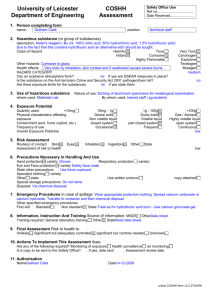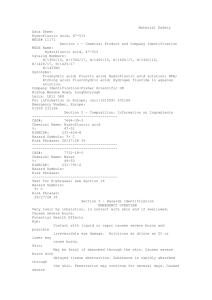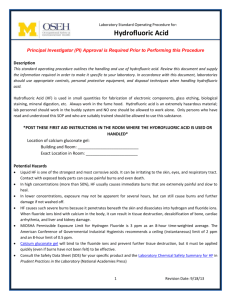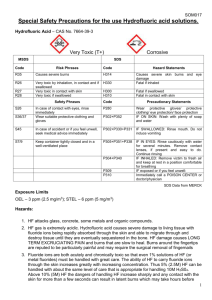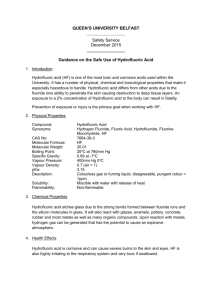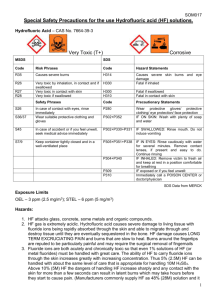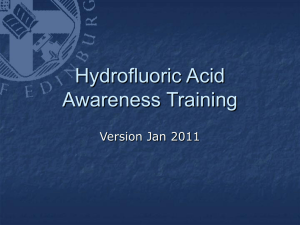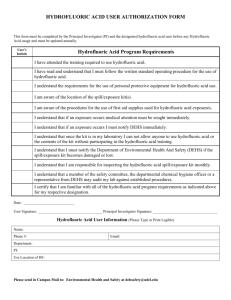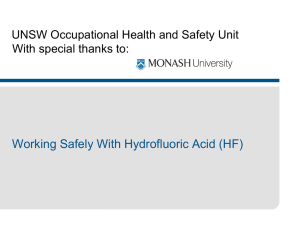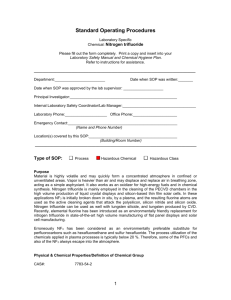Hydrofluoric Acid - WSU Environmental Health & Safety
advertisement
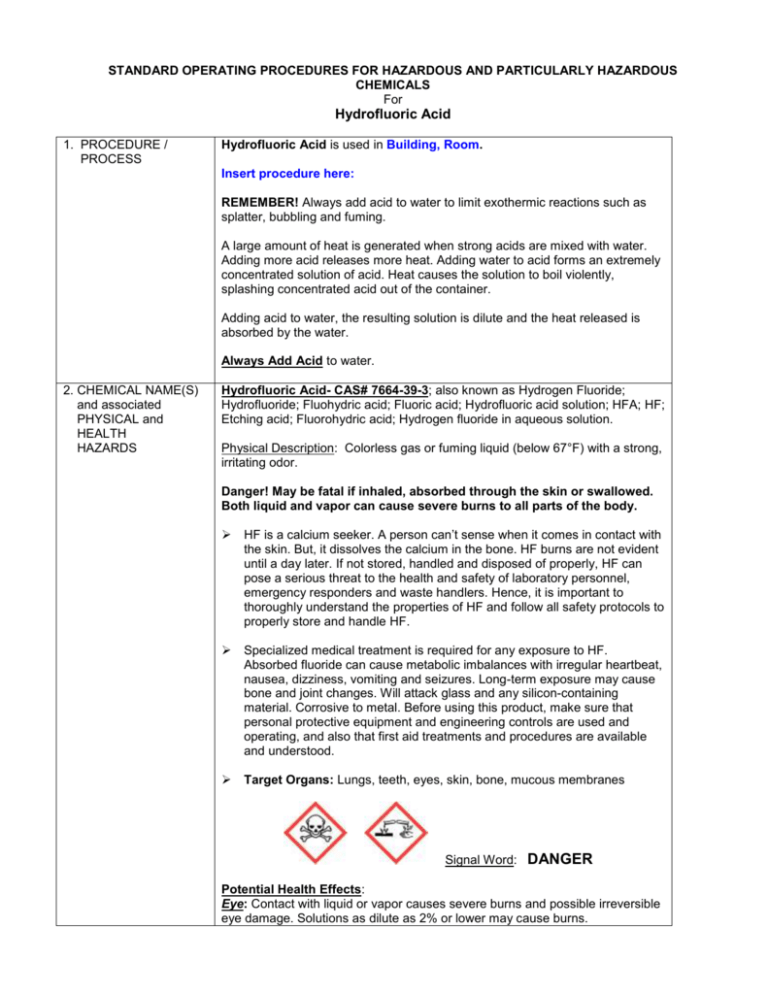
STANDARD OPERATING PROCEDURES FOR HAZARDOUS AND PARTICULARLY HAZARDOUS CHEMICALS For Hydrofluoric Acid 1. PROCEDURE / PROCESS Hydrofluoric Acid is used in Building, Room. Insert procedure here: REMEMBER! Always add acid to water to limit exothermic reactions such as splatter, bubbling and fuming. A large amount of heat is generated when strong acids are mixed with water. Adding more acid releases more heat. Adding water to acid forms an extremely concentrated solution of acid. Heat causes the solution to boil violently, splashing concentrated acid out of the container. Adding acid to water, the resulting solution is dilute and the heat released is absorbed by the water. Always Add Acid to water. 2. CHEMICAL NAME(S) and associated PHYSICAL and HEALTH HAZARDS Hydrofluoric Acid- CAS# 7664-39-3; also known as Hydrogen Fluoride; Hydrofluoride; Fluohydric acid; Fluoric acid; Hydrofluoric acid solution; HFA; HF; Etching acid; Fluorohydric acid; Hydrogen fluoride in aqueous solution. Physical Description: Colorless gas or fuming liquid (below 67°F) with a strong, irritating odor. Danger! May be fatal if inhaled, absorbed through the skin or swallowed. Both liquid and vapor can cause severe burns to all parts of the body. HF is a calcium seeker. A person can’t sense when it comes in contact with the skin. But, it dissolves the calcium in the bone. HF burns are not evident until a day later. If not stored, handled and disposed of properly, HF can pose a serious threat to the health and safety of laboratory personnel, emergency responders and waste handlers. Hence, it is important to thoroughly understand the properties of HF and follow all safety protocols to properly store and handle HF. Specialized medical treatment is required for any exposure to HF. Absorbed fluoride can cause metabolic imbalances with irregular heartbeat, nausea, dizziness, vomiting and seizures. Long-term exposure may cause bone and joint changes. Will attack glass and any silicon-containing material. Corrosive to metal. Before using this product, make sure that personal protective equipment and engineering controls are used and operating, and also that first aid treatments and procedures are available and understood. Target Organs: Lungs, teeth, eyes, skin, bone, mucous membranes Signal Word: DANGER Potential Health Effects: Eye: Contact with liquid or vapor causes severe burns and possible irreversible eye damage. Solutions as dilute as 2% or lower may cause burns. Skin: May be fatal if absorbed through the skin. Causes severe burns with delayed tissue destruction. Substance is rapidly absorbed through the skin. Penetration may continue for several days. Causes severe tissue necrosis and bone destruction. Both liquid and vapor can cause severe burns, which may not be immediately painful or visible. Solutions as dilute as 2% or lower may cause burns. Systemic fluoride toxicity from exposure to hydrofluoric acid may result in severe hypocalcemia, hypomagnesemia, hyperkalemia, metabolic acidosis, cardiac dysrhythmias, and death. Burns caused by weak hydrofluoric acid may go unnoticed for several hours. Therefore, first aid procedures must be followed if any contact is suspected. Ingestion: Causes severe digestive tract burns with abdominal pain, vomiting, and possible death. Human fatalities have been reported from acute poisoning. Systemic fluoride toxicity from exposure to hydrofluoric acid may result in severe hypocalcemia (depletion of calcium in the blood), hypomagnesemia, hyperkalemia, metabolic acidosis, cardiac dysrhythmias, and death. Inhalation: May be fatal if inhaled. May cause severe irritation of the upper respiratory tract with pain, burns, and inflammation. May cause pulmonary edema and severe respiratory disturbances. Depletes calcium levels in the body which can lead to hypocalcemia and death. Concentrations of hydrofluoric acid above 40% fume in air. Chronic: Chronic inhalation and ingestion may cause chronic fluoride poisoning (fluorosis) characterized by weight loss, weakness, anemia, brittle bones, and stiff joints. Repeated inhalation may cause chronic bronchitis. Chronic exposure to fluoride compounds may cause systemic toxicity. Skeletal effects may include bone brittleness, joint stiffness, teeth discoloration, tendon calcification, and osterosclerosis. Chronic ingestion or inhalation may cause weight loss, malaise, anemia, leukopenia (reduction in the number of white blood cells in the blood), discoloration of the teeth and osteosclerosis (the hardening or abnormal density of bone). Repeated inhalation may cause osteofluorosis and permanent respiratory damage. Exposure Limits: DOSH: CEIL: 3 ppm OSHA: TWA: 3 ppm NIOSH: TWA: 3 ppm; CEIL: 6 ppm [15 minute] ACGIH: TWA: 0.5 ppm; CEIL: 2 ppm Toxicological Data: INHALATION (LC50): 1,276 ppm 1 hour [Rat]; 342 ppm 1 hour [Mouse]; 1,774 ppm 1 hour [Monkey]; 4,327 ppm 0.5 hour [Guinea Pig] *Always refer to the Safety Data Sheet for the most detailed information* 3. NAME OF TRAINER / RESOURCE PERSON 4. LOCATION OF HEALTH & SAFETY INFORMATION Principal Investigator Name, Building, Room, Phone Number Secondary contact Name, Building, Room, Phone Number The Safety Data Sheet (SDS) for Hydrofluoric Acid is located in the Laboratory Safety Manual in Building, Room Labeling: In addition to the standard label that identifies contents, hazards, precautionary measures, and emergency contact information, containers should also be marked identifying the substance as highly corrosive and highly toxic. 5. PROTECTIVE EQUIPMENT Wear chemical splash goggles and face shield, fully buttoned lab coat, clothing that covers the body including long pants and closed toe shoes, disposable nitrile under-gloves and arm length nitrile, neoprene, or butyl over-gloves. An impervious apron or suit is also recommended. Work within a properly functioning, certified laboratory chemical fume hood designated specifically for HF use. Facilities storing or utilizing this material should be equipped with an emergency eyewash facility and a safety shower. 6. WASTE DISPOSAL PROCEDURES Waste Hydrofluoric Acid should be collected in an approved plastic container obtained with appropriate vented cap. The container should be stored away from incompatible materials such as metals, organic materials, strong bases, strong acids, oxidizing agents, amines, metal salts, silicon compounds, water, or steam. A completed Dangerous Waste label should be attached when waste is first added to the container. When container is full or no longer being used complete and submit a Chemical Collection Request Form. 7. DESIGNATED AREA INFORMATION The Hydrofluoric acid is stored and dispensed in Building, Room. Always work within a certified laboratory fume hood designated for HF use. Use a corrosion-resistant ventilation system. If closed handling systems are not feasible, use local exhaust ventilation such as a wash down fume hood Keep the fume hood sash as low as possible. The designated area(s) should be shown on the floor plan in Laboratory’s Chemical Hygiene Plan. 8. DECONTAMINATION PROCEDURES Upon Accidental Exposure: SPEEDY ACTION IS CRITICAL! GET MEDICAL ATTENTION IMMEDIATELY! ADVISE 911 HF IS INVOLVED. Eyes: Do NOT allow victim to rub eyes or keep eyes closed. Spills of HF should be flushed in eyewash or shower for at least 15 to 30 minutes until medical attention arrives. Keep eyelids apart from the eyeballs during irrigation. Do not use HF skin burn treatments on the eyes. Skin: Immediately flush skin with water for at least 15 minutes until medical attention arrives while discarding contaminated clothing in a manner which limits further exposure. After thorough washing, a 2.5% calcium gluconate gel, if available, should be continuously massaged into the burned area until medical help arrives. Calcium gluconate must be kept on hand at all times. Replace annually if not previously used. Before using HF, make sure the antidote and first aid attendant are available in case of exposure. Ingestion: Do not induce vomiting. Get medical aid immediately. SPEED IS ESSENTIAL. A DOCTOR MUST BE NOTIFIED AT ONCE. Inhalation: SPEED IS ESSENTIAL, OBTAIN MEDICAL AID IMMEDIATELY. If inhaled remove victim to fresh air immediately. POISON material. Do not perform artificial respirations without a mask! *Antidote: Always have calcium gluconate gel on hand. Upon Accidental Release: Large Spill: If a significant amount of hydrofluoric acid is spilled outside the fume hood, immediately evacuate, secure area, and call 911 to contact EH&S. Small Spill: If a small amount of hydrofluoric acid is spilled (it can be cleaned up in 10 minutes) and you have been appropriately trained to clean it up, you may do so. Trained personnel should wear at the minimum clothing that covers the body including long pants and closed toe shoes, disposable nitrile undergloves, arm length nitrile, neoprene, or butyl over-gloves, chemical safety goggles and a face shield, a fully-buttoned lab coat and an impervious apron or suit. Additional PPE such as respirators may be necessary depending upon material and concentration. (Note: You must be medically cleared, fit tested and enrolled in WSU’s respiratory protection program to wear a respirator). If it is necessary to use a respirator and personnel are not cleared to wear a respirator and not trained to appropriately clean up the spill, the employee should immediately evacuate, secure area, and call 911 to contact EH&S. Absorb with an inert dry material and place material in an appropriate waste disposal container (resealable bag, etc.) and dispose of as hazardous waste (see above WASTE DISPOSAL PROCEDURES). As with all accidents, report any exposure as soon as possible to your Principal Investigator or Supervisor. Additional health and safety information on hydrofluoric acid can be obtained by referring to the SDS or by calling the EH&S Office (335-3041). 9. SPECIAL STORAGE AND HANDLING PROCEDURES Handling Wash thoroughly after handling. Remove contaminated clothing and wash before reuse. Discard contaminated shoes. Do not get in eyes, on skin, or on clothing. Keep container tightly closed. Use caution when opening. Do not breathe vapor or mist. Use only with adequate ventilation or respiratory protection. Do not put even dilute solutions of hydrofluoric acid in glass containers. Always add the acid to water, never the reverse. Never work alone with this chemical. Storage Store in a cool, dry, well-ventilated area away from incompatible substances such as metals, organic materials, strong bases, strong acids, oxidizing agents, amines, metal salts, silicon compounds, water, or steam. Do not store in metal or glass containers. Store in a polyethylene or polypropylene container (e.g. Nalgene). Corrosive to metals. Will attack glass and concrete. Store in a corrosives area within a secondary containment tray or tub made of polyethylene or polypropylene (e.g. Nalgene). Keep container tightly closed. Inspect periodically for damage or evidence of leaks or corrosion. Certification of Hazard Assessment Is this document a certification of Hazard Assessment for the processes identified within? Yes No If yes, provide the name of the person certifying the Hazard Assessment and the date it was performed: ____________________________________________________________________________________ Name Date The location of the Hazard Assessment is indicated in the document preceding this form. Certificate of Employee Training Name of person providing training for employees working with this process: ___________________________________________________________________________________ The following employees have been trained in when, where and how to use selected PPE, the maintenance, limitations and disposal of the PPE selected, and have demonstrated the correct use of the PPE selected on the reverse of this certification. Name Date Trained ________________________________________ _______________________________ ________________________________________ _______________________________ ________________________________________ _______________________________ ________________________________________ _______________________________ ________________________________________ _______________________________ ________________________________________ _______________________________ ________________________________________ _______________________________
